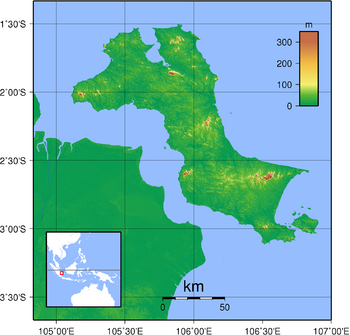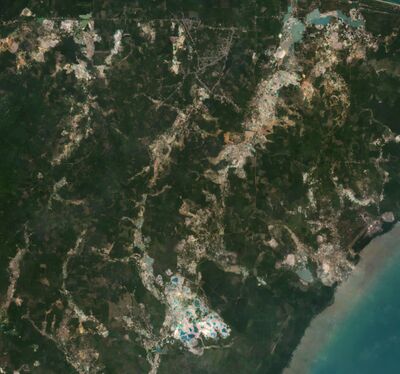جزيرة بانكا
الاسم الأصلي: باڠكا | |
|---|---|
 طبوغرافيا جزيرة باڠكا | |
 | |
| الجغرافيا | |
| الموقع | جنوب شرق آسيا |
| الإحداثيات | 2°15′S 106°00′E / 2.250°S 106.000°E |
| المساحة | 11،693.54 km2 (4،514.90 sq mi) |
| ترتيب المساحة | 68th |
| أعلى منسوب | 665 m (2٬182 ft) |
| أعلى نقطة | Gunung Bui |
| الإدارة | |
| المقاطعات | پنكال پيناڠ، مركز بانكا، وسط باڠكا، جنوب باڠكا، غرب باڠكا |
| Largest settlement | پنكال پيناڠ (pop. 134,082) |
| السكان | |
| اسم المواطن | Bangkan |
| التعداد | 1,146,581 (تعداد 2020) |
| الكثافة السكانية | 98٫05 /km2 (253٫95 /sq mi) |
| الجماعات العرقية | Malay Indonesians and Chinese, mostly Hakkas |
جزيرة باڠكا أو بانكا (Bangka Island ، وأحياناً تُدعى Bangka) هي جزيرة تقع شرق سومطرة. وقد اعتادت أن تكون جزءاً إدارياً من سومطرة، إندونيسيا، إلا أنها انفصلت لتشكل الجزء الرئيسي من مقاطعة بانكا بليتونغ الجديدة، لكونها أحد سَميات المحافظة مع جزيرة بليتونگ الأصغر عبر مضيق گاسپار. وهي تاسع أكبر جزر إندونيسيا،[1] وبلغ عدد سكانها 1,146,581 نسمة في تعداد 2020.[2] وهي مقر عاصمة المقاطعة پنكال پيناڠ، وتنقسم إدارياً إلى أربع مراكز ومدينة.
الجغرافيا
Bangka is an island province together with Belitung Island. It lies just east of Sumatra, separated by the Bangka Strait; to the north lies the South China Sea, to the east, across the Gaspar Strait, is the island of Belitung, and to the south is the Java Sea. It is about 12,000 km². Most of its geography consists of lower plains, swamps, small hills, and beautiful beaches. It has white pepper fields, many palm trees and rubber trees, and well-known tin mines.
Its largest city is Pangkal Pinang which is also the capital of Bangka-Belitung Province. Sungai Liat is its second-largest city. Mentok (formerly Muntok) is the principal port in the west. Other important towns are Toboali in the southern region; Koba, an important tin-mining town, also in the southern part of the island; and Belinyu, which is famous for its seafood products. Bangka has four seaports: Mentok, in the far west; Belinyu, in the far north; Sadai, in the far south; and Pangkal Balam, in Pangkal Pinang, where the government is contemplating the construction of a nuclear power station. [3]
The population was 626,955 in 1990,[4] 960,692 at the 2010 census and 1,146,581 at the 2020 Census;[5] the area is 11،693.54 متر كيلومربع (4،514+7⁄8 ميل مربع).
التاريخ
During the glacial periods, Bangka was connected to mainland Asia similarly with the larger islands of Java, Sumatra, and Borneo as part of the Sunda Shelf, and got separated once the sea level rose.
The Kota Kapur inscription, dated from 686 CE, was found in Bangka in 1920, showed Srivijayan influence on the island around the 7th century.[6] Later, the island was conquered by an expedition from Majapahit, led by Gajah Mada, which appointed local rulers and established social structures. As the empire declined, Bangka fell into neglect.
Bangka was recorded as Pengjia hill (彭加山) in the 1436 Xingcha Shenglan, compiled by the Chinese soldier Fei Xin during the treasure voyages of Admiral Zheng He. Contemporary records show that the area - close to the busy Strait of Malacca and waters of the Musi River - had significant presence of Chinese traders.[7]
Later on, the island was taken over by the Johor and Minangkabau Sultanates which introduced Islam to the island. It continued to pass to the Banten Sultanate before it was then inherited by the nearby Palembang Sultanate sometime in the late 17th century. Soon after, around 1710, tin was discovered on the island which attracted migrants from across the archipelago and beyond.[8] Descendants of the Chinese immigrants, mainly from Guangdong, still form a large portion of modern Bangka's inhabitants.
As tin mining developed further, the Palembang Sultanate sent for experts in Malay Peninsula and China. The Dutch East India Company managed to secure a monopolistic tin purchase agreement in 1722, but hostilities began to develop between the Sultan and the Dutch. During the British invasion of Java in 1811, then-Sultan Mahmud Badaruddin attacked and massacred the staff of the Dutch post on the island. He was later deposed and executed by the British.[8] His successor ceded Bangka to Britain in 1812, but in 1814 Britain exchanged it with the Dutch for Cochin in India following the Anglo-Dutch Treaty of 1814.
Around the late years of the 18th century, Bangka was an important production center of tin in Asia, with annual outputs hovering around 1,250 tons.[7] In 1930 Bangka had a population of 205,363.[9] Japan occupied the island from February 1942 to August 1945 during World War II. The Japanese military perpetrated the Bangka Island massacre against Australian nurses and British and Australian servicemen and civilians.
During the Indonesian National Revolution, republican leaders Sukarno and Hatta were exiled in Bangka in the aftermath of Operation Kraai. Bangka became part of independent Indonesia in 1949. The island, together with neighboring Belitung, was formerly part of South Sumatra (Sumatera Selatan) province, but in 2000 the two islands became the new province of Bangka-Belitung. In the recent years, tin mining has declined notedly, although it is still a major part of the island's economy.
Bangka is also home to a number of communist Indonesians who have been under house arrest since the 1960s anti-Communist purge and are not permitted to leave the island.[بحاجة لمصدر]
الاقتصاد
القصدير والقضايا البيئية
Since circa 1710, Bangka has been one of the world's main tin-producing centers. Tin production is a government monopoly in Indonesia. There is a tin smelter at Muntok.[4] Indonesia is the second-largest tin producer and exporter in the world. Indonesia's largest tin production is produced on Bangka Island which makes it a strategic area for Indonesia in terms of world tin trade. But heavy tin exploitation caused environmental damage and much of the land suffers from infertility after being turned into (often illegal) tin mine. Irresponsible miners let the mine land become trenches filled with water and the surrounding land becomes arid with nothing to grow. This is a critical environmental issue.[10][11][12]
غيره
الفلفل الأبيض يُنتَج أيضاً في الجزيرة.
السكان
The majority of the inhabitants are Malays and Chinese, mostly Hakkas. The population is split between those work on the tin mines, palm oil plantations, rubber plantations, fisherman and those who work on pepper farms.
انظر أيضاً
المراجع
- ^ "Largest Islands of Indonesia". Retrieved 4 August 2017.
- ^ Badan Pusat Statistik, Jakarta, 2021.
- ^ "Indonesian Government Eyeing Bangka Island for 2 Nuclear Power Plants". Jakarta Globe. 2010. Retrieved 2013-11-03.
- ^ أ ب "Bangka." Columbia Gazetteer of the World Online. 2013. Columbia University Press. 01 Nov. 2013. [1]
- ^ Badan Pusaty Statistik, Jakarta, 2021.
- ^ Sujitno, Sutedjo (2011). Legenda dalam sejarah Bangka. Jakarta: Cempaka Publishing. p. 281. OCLC 958845419.
- ^ أ ب Utomo, Bambang Budi. "Bangka-Belitung dalam Lintas Niaga" (PDF) (in الإندونيسية). Indonesian Ministry of Education. Retrieved 4 August 2017.
- ^ أ ب Abdullah, Husnial Husin (1983). Sejarah Perjuangan Kemerdekaan R.I. Di Bangka Belitung. Karya Unipress. p. 393.
- ^ Columbia-Lippincott Gazetter
- ^ Hodal, Kate (2012-11-23). "Death metal: tin mining in Indonesia". the Guardian. Retrieved 2023-02-25.
If you own a mobile, it's probably held together by tin from the Indonesian island of Bangka. Mining is wrecking the environment and every year it claims dozens more lives
- ^ "Illegal mining fuels social conflict in Indonesian tin hub of Bangka-Belitung". Mongabay Environmental News. 2022-02-24. Retrieved 2023-02-25.
Tin mining is the backbone of the Bangka Belitung economy, but has also proven deadly for workers and damaging to coral reefs, mangrove forests and local fisheries.
- ^ "Net Social Impact of Illegal Unconventional Onshore Tin Mining in South Bangka, Bangka Island". IOP Conference Series: Earth and Environmental Science. 353 (1): 012026. 1 October 2019. doi:10.1088/1755-1315/353/1/012026.
- Pages using gadget WikiMiniAtlas
- CS1 الإندونيسية-language sources (id)
- Short description is different from Wikidata
- Articles with hatnote templates targeting a nonexistent page
- Coordinates on Wikidata
- Articles with unsourced statements from June 2008
- Landforms of the Bangka Belitung Islands
- جزر سومطرة
- الحكم البريطاني في إندونيسيا
- تأسيسات 1812 في الامبراطورية البريطانية
- تأسيسات 1814 في الامبراطورية الهولندية
- صفحات مع الخرائط


